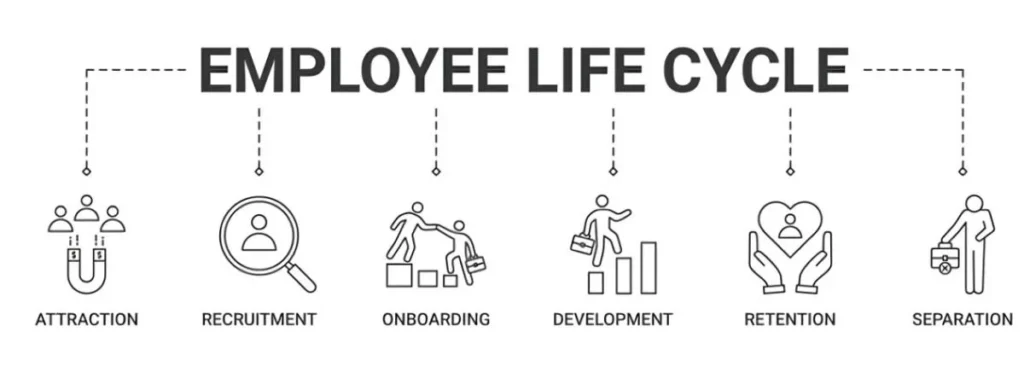GENERAL
Comprehensive Guide to Effective Employee Offboarding: Best Practices and Key Considerations

An employee’s journey within an organization typically follows a structured life cycle, beginning with recruitment, moving through onboarding, development, and performance management, and eventually leading to offboarding. While the early stages of this cycle often receive significant attention, the final phase—offboarding—can be just as impactful. A carefully crafted offboarding process provides benefits for both the organization and the departing employee, ensuring a smooth transition and safeguarding the company’s security and reputation. The exit process for employees is a structured approach to managing an employee’s departure from an organization, ensuring a smooth transition and addressing administrative, security, and knowledge transfer needs.
Here, we explore best practices, essential components, and key benefits of a strategic offboarding process. A well-executed offboarding process can even contribute to improving the retention rate of employees, as it highlights the organization’s commitment to respecting and valuing every phase of the employee life cycle.
Table of Contents
What Is Employee Offboarding?
Employee offboarding is the process of managing an employee’s departure from the organization, marking the last phase of their employment life cycle. Effective offboarding aims to ensure a smooth and respectful transition, minimizing operational disruptions and reinforcing positive relationships. By following a structured approach, companies can mitigate potential security risks, gain valuable feedback, and leave a lasting positive impression on departing employees.

Why Offboarding Matters: Benefits for Organizations and Employees
An intentional offboarding strategy brings a range of advantages. By considering both the organization’s and the employee’s needs, companies can approach offboarding as an opportunity to strengthen their brand, improve operational continuity, and foster goodwill.
Organizational Benefits
- Enhanced Security and Compliance: A comprehensive offboarding process reduces the risk of data breaches and ensures that access to sensitive information is appropriately managed.
- Legal and Financial Protection: Clear policies around termination and benefits reduce the likelihood of legal disputes and clarify final financial matters.
- Reputation Management: Positive offboarding experiences contribute to the organization’s reputation, encouraging potential rehires and referrals.
- Operational Continuity: A well-planned offboarding process allows for smoother transitions, reducing productivity losses by adequately preparing the remaining team.
- Insight and Improvement: Exit interviews and surveys provide insights into organizational culture, leadership, and other factors affecting employee retention.
Employee Benefits
- Closure and Transparency: Providing departing employees with information about their final paycheck, benefits, and other concerns promotes clarity and peace of mind.
- Supportive Transition: Offering outplacement services or resources demonstrates the company’s commitment to employee welfare, helping departing employees smoothly transition to new roles.
- Respect and Positive Farewell: By allowing employees to announce their departure on their terms and acknowledge their contributions, companies foster a respectful and positive exit experience.
- Opportunities for Feedback: Structured offboarding processes encourage honest dialogue, empowering employees to share feedback without fear of repercussion.
Key Components of a Successful Offboarding Process
An effective offboarding program consists of several core steps, each aimed at ensuring a smooth transition and addressing both organizational and employee needs.
1. Notice Period and Transition Planning
The notice period, typically specified in employment contracts, serves as a time for both parties to prepare for the departure. During this time, the company can begin transitioning responsibilities and document key procedures, while the departing employee has an opportunity to finalize their work and hand over tasks to successors.
Expert Tip: Early knowledge transfer between the departing employee and their replacement can make the transition smoother for everyone involved.
2. Offboarding Tasks and Checklist Creation
Creating a detailed offboarding checklist is crucial for managing each aspect of an employee’s departure. A checklist may include the following steps:
- Notify Relevant Departments: Inform HR, IT, and accounting departments about the employee’s exit, ensuring they take necessary actions related to payroll, benefits, and system access.
- Retrieve Company Assets: Issue a property return letter to collect laptops, ID badges, company phones, and any other organizational assets.
- Complete Documentation: Ensure that all required paperwork related to the termination of employment is properly filed.
Having a standardized checklist simplifies the offboarding process, reduces the risk of overlooked tasks, and helps maintain a record of the exit procedures for future reference.

3. Knowledge Transfer and Task Reassignment
Departing employees should document their day-to-day tasks, including any active projects, to facilitate a smoother handover. By clearly defining responsibilities and transferring knowledge, the organization minimizes the potential productivity gaps that may occur when an employee leaves.
Do: Arrange for an in-person handover whenever possible to enhance knowledge transfer effectiveness.
4. Conducting an Exit Interview
Exit interviews provide an invaluable opportunity to understand the departing employee’s reasons for leaving and their perceptions of the organization. Questions may cover areas like management effectiveness, workplace culture, and potential improvements. The insights gained can guide future employee retention strategies and address systemic issues that could lead to higher turnover.
Tip: Centralize exit interview data to identify trends and share them with senior management for ongoing organizational improvement.
5. IT Security and Compliance Measures
Protecting sensitive information is essential during the offboarding process. Without proper controls, departing employees may still have access to data or systems, increasing the risk of a security breach. Some key steps include:
- Account Deactivation: Disable the employee’s access to all company systems, including on-premises and cloud-based accounts.
- Email and Call Forwarding: Redirect incoming communications to prevent disruptions, especially if the exiting employee managed client or partner relationships.
- Review Access Roles: Ensure that any projects or accounts where the departing employee was the primary contact are reassigned.
These measures are vital to safeguarding company data, reducing compliance risks, and ensuring a secure handover.
6. Confidentiality and Professional Conduct
Employees should be reminded of any confidentiality agreements they signed, reinforcing the importance of safeguarding sensitive information even after they leave. Maintaining a respectful and professional attitude throughout the offboarding process not only benefits the departing employee but also leaves a positive impression that can have far-reaching effects on the organization’s reputation.
Best Practices for a Smooth and Effective Offboarding
Implementing a few strategic practices can enhance the effectiveness of the offboarding process and ensure the experience is positive for all parties involved.
Clear Communication
Ensuring that exit procedures and expectations are clearly communicated can help alleviate confusion or anxiety for the departing employee. This includes clarifying the timeline, processes, and any information regarding benefits or continued access to company resources.
Thorough Documentation
Documenting every step in the offboarding process, including any discussions, agreements, or exit interviews, is crucial for legal compliance and accountability. A detailed record of the offboarding process also provides the organization with data to review and improve the process continually.
Continuous Improvement
Offboarding procedures should be regularly reviewed to adapt to any changes in organizational needs or industry standards. Gathering feedback from employees who have recently exited can help identify areas for improvement, enabling the organization to refine its approach and enhance future experiences.
Conclusion: Prioritizing Offboarding for Organizational Success
Offboarding, while often overshadowed by onboarding, is an essential part of the employee life cycle that should not be overlooked. By approaching it with the same level of care as onboarding, organizations can create a positive exit experience that minimizes disruptions, safeguards security, and enhances their reputation. The components of a successful offboarding strategy—from effective knowledge transfer and secure IT practices to exit interviews and respectful farewells—work together to ensure a seamless transition for departing employees and ongoing stability for the organization.
By implementing these best practices, organizations can turn offboarding into a powerful tool for building long-term success, fostering a positive workplace culture, and enhancing relationships with both current and former employees.
Looking for more tips? Explore our blog for valuable insights and updates!
-

 GENERAL2 months ago
GENERAL2 months agoUncovering the World of кинокрадко: The Dark Side of Film Piracy
-

 GENERAL2 weeks ago
GENERAL2 weeks agoUnveiling the Art of преводсч: How Translators Bridge Language Barriers
-

 YOGA1 year ago
YOGA1 year ago4 Person Yoga Poses for Beginners
-

 GENERAL2 months ago
GENERAL2 months agoThe Journey of iamnobody89757: From Anonymous User to Internet Sensation























